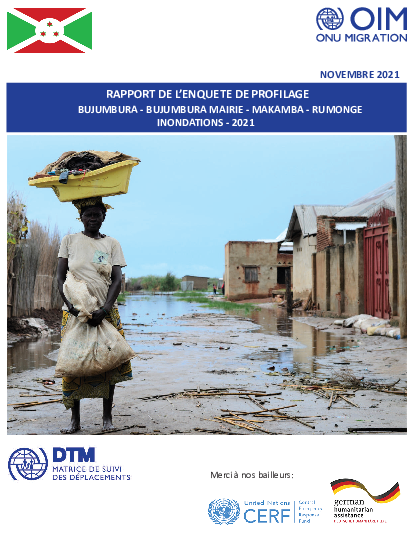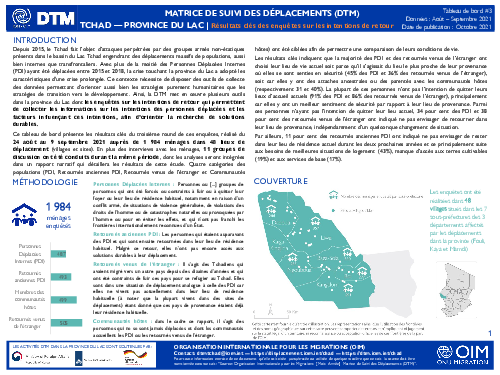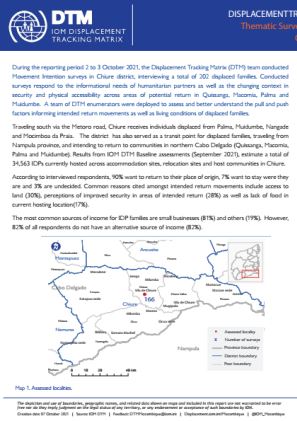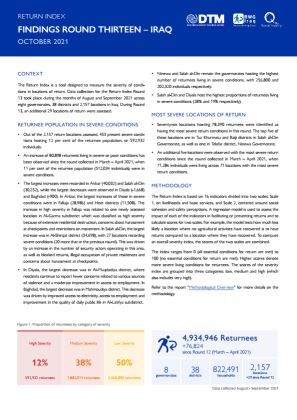-
Countries
-
Data and Analysis
-
Special Focus
-
Crisis Responses
Return Intention

Contact
DTM Burundi, DTMBurundi@iom.int
Language
French
Location
Burundi
Period Covered
Mar 01 2021
May 31 2021
Activity
- Survey
- Return Intention
Entre mars et mai 2021, les provinces de Bujumbura, Bujumbura Mairie, Rumonge et Makamba ont été fortement touchées par des inondations dues à la montée des eaux du Lac Tanganyika qui ont affecté environ 52,000 personnes dont 22 000 déplacées. Dans la province de Bujumbura, certaines personnes déplacées ont été installées dans les sites de Sobel et Kinyinya II qui hébergeaient déjà des personnes déplacées par les inondations de 2020. Dans les autres provinces de Bujumbura Mairie, Rumonge et Makamba, les personnes déplacées étaient logées dans les communautés d’accueil. Dans le cadre de l’enquête de profilage, tous les nouveaux ménages déplacés vivant dans les sites de Sobel et Kinyinya II, et ceux résidant dans les provinces de Bujumbura Mairie, Rumonge et Makamba ont été profilés. Un total de 3 988 ménages déplacés (20 106 personnes) ont été enquêtés.

Contact
DTM Chad, dtmtchad@iom.int
Language
English
Location
Chad
Period Covered
Aug 01 2021
Sep 30 2021
Activity
- Survey
- Return Intention
Depuis 2015, le Tchad fait l’objet d’attaques perpétrées par des groupes armés non-étatiques présents dans le bassin du Lac Tchad engendrant des déplacements massifs de populations, aussi bien internes que transfrontaliers. Avec plus de la moitié des Personnes Déplacées Internes (PDI) ayant été déplacées entre 2015 et 2018, la crise touchant la province du Lac a adopté les caractéristiques d'une crise prolongée. Ce contexte nécessite de disposer des outils de collecte des données permettant d’orienter aussi bien les stratégies purement humanitaires que les stratégies de transition vers le développement. Ainsi, la DTM met en œuvre plusieurs outils dans la province du Lac dont les enquêtes sur les intentions de retour qui permettent de collecter les informations sur les intentions des personnes déplacées et les facteurs influençant ces intentions, afin d’orienter la recherche de solutions durables. Ce tableau de bord présente les résultats clés du troisième round de ces enquêtes, réalisé du 24 août au 9 septembre 2021 auprès de 1 984 ménages dans 48 lieux de déplacement (villages et sites). En plus des interviews avec les ménages, 11 groupes de discussion ont été conduits durant la même période, dont les analyses seront intégrées dans un rapport narratif qui détaillera les résultats de cette étude. Quatre catégories des populations (PDI, Retournés anciennes PDI, Retournés venus de l’étranger et Communautés hôtes) ont été ciblées afin de permettre une comparaison de leurs conditions de vie.

Contact
DTM Chad, dtmtchad@iom.int
Language
English
Location
Chad
Period Covered
Aug 01 2021
Sep 30 2021
Activity
- Survey
- Return Intention
Since 2015, there has been an increase in attacks by non-state armed groups in Chad, specifically in the Lake Chad Basin area, resulting in massive internal and cross-border displacement. The crisis affecting the Lake Province has adopted the characteristics of a protracted crisis, with more than half of Internally Displaced Persons (IDPs) having been displaced between 2015 and 2018. This context requires data collection tools to guide both humanitarian and nexus strategies. Thus, the Displacement Tracking Matrix (DTM) implements several tools in the Lake Province, including return intention surveys, which aim at collecting information on the intentions of displaced persons and the factors influencing these intentions, in order to inform the development of durable solutions.
This dashboard presents key findings from the third round of return intention surveys in the Lake Province, conducted from 24 August to 9 September 2021, with 1,984 households in 48 displacement locations (villages and sites). In addition to household interviews, 11 focus groups were conducted within the same period, whose analyses will be incorporated into a narrative report detailing the results of this study. Four categories of populations (IDPs, former IDP returnees, returnees from abroad, and host communities) were surveyed to make a comparison of their living conditions

Contact
DTM Support, DTMSupport@iom.int
Language
English
Location
Mozambique
Period Covered
Oct 01 2021
Oct 01 2021
Activity
- Return Intention
On the 1 October 2021, the Displacement Tracking Matrix (DTM) team conducted Movement Intention surveys in Balama district, interviewing a total of 94 displaced families. Conducted surveys respond to the informational needs of humanitarian partners as well as the changing context in security and physical accessibility across areas of potential return in Quissanga, Macomia, Palma and Muidumbe. A team of DTM enumerators were deployed to assess and better understand the pull and push factors informing intended return movements as well as living conditions of displaced families.

Contact
DTM Support, DTMSupport@iom.int
Language
English
Location
Mozambique
Period Covered
Oct 02 2021
Oct 03 2021
Activity
- Return Intention
During the reporting period 2 to 3 October 2021, the Displacement Tracking Matrix (DTM) team conducted Movement Intention surveys in Chiure district, interviewing a total of 202 displaced families. Conducted surveys respond to the informational needs of humanitarian partners as well as the changing context in security and physical accessibility across areas of potential return in Quissanga, Macomia, Palma and Muidumbe. A team of DTM enumerators were deployed to assess and better understand the pull and push factors informing intended return movements as well as living conditions of displaced families.

Contact
DTM Support, DTMSupport@iom.int
Language
English
Location
Mozambique
Period Covered
Sep 28 2021
Sep 30 2021
Activity
- Survey
- Return Intention
During the reporting period 28 to 30 September 2021, the Displacement Tracking Matrix (DTM) team conducted Movement Intention surveys in Montepuez district, interviewing a total of 1,062 displaced families. Conducted surveys respond to the informational needs of humanitarian partners as well as the changing context in security and physical accessibility across areas of potential return in Quissanga, Macomia, Palma and Muidumbe. A team of DTM enumerators were deployed to assess and better understand the pull and push factors informing intended return movements as well as living conditions of displaced families.

Contact
DTM Mozambique, DTMMozambique@iom.int
Language
English
Location
Mozambique
Period Covered
Oct 07 2021
Oct 15 2021
Activity
- Return Intention
- Mobility Tracking
From 07 to 15 October 2021, Population Count exercises in Bandar and Ntocota (Metuge district); Mirate and Mararange (Montepuez district); and Nanjua A (Ancuabe district) Relocation Sites were conducted in collaboration with IOM DTM and IOM CCCM in close coordination with the CCCM cluster.

Contact
DTM Iraq, IraqDTM@iom.int
Language
English
Location
Iraq
Period Covered
Aug 01 2021
Sep 30 2021
Activity
- Survey
- Return Intention
- Mobility Tracking
- Baseline Assessment
The Return Index is a tool designed to measure the severity of conditions in locations of return. Data collection for the Return Index Round 13 took place during the months of August and September 2021 across eight governorates, 38 districts and 2,157 locations in Iraq. During Round 13, an additional 29 locations of return were assessed.

Contact
DTM Ethiopia, SLOAddisAbabaDTM@iom.int
Language
English
Location
Ethiopia
Period Covered
Jul 01 2021
Jul 31 2021
Activity
- Survey
- Community Perception
- Return Intention
In July 2021, the International Organization for Migration (IOM)'s Displacement Tracking Matrix (DTM), Camp Coordinaton and Camp Management (CCCM) Cluster and Protection Cluster worked together to carry out household level intention surveys in Tigray region for the first time. In response to this changing mobility context, the purpose of the household level intention survey was to better understand the intention of IDPs in urban areas with high displacement concentrations, the barriers preventing their preferred durable solution and the support needed to pursue that durable solution. The household level intention survey was conducted in Abi Adi, Adigrat, Adwa, Axum, Mekelle, Sheraro and Shire, where representative sampling was deployed in each of these 7 urban areas.
In terms of preferred durable solutions, 89% of respondents wanted to return to their places of origin, 10% wanted to locally integrate, less than 1% wanted to relocate/resettle and less than 1% was unsure or preferred not to answer the question. Of those who wanted to return, 95% stated that the availability of food was the main factor that needs to be ensured before starting return. This was followed by the need for safety and security as stated by 64% of respondents, the renovation or reconstruction of shelter by 40% of respondents and the avaibility of livelihoods options as mentioned by 29% of respondents. 53% of surveyed IDPs cited that they originated from Western zone while 28% of surveyed IDPs cited that they came from Northwestern zone. Meanwhile, an overwhelming majority of IDP households surveyed (99%) said that their main need is food. This was followed by shelter, as mentioned by 71% of IDP households and non-food items (NFIs) as mentioned by 63% of IDP households.
In light of these intentions and needs, recommendations have also been made at the end of the report. This includes that IDPs should be given the option to return, resettle in suitable locations within Tigray, or remain in their areas of displacement until they voluntarily decide to return or resettle elsewhere. They should be free to choose whether to receive humanitarian assistance in their location of displacement, return or resettlement.

Contact
DTM REMAP Support Team, dtmremap@iom.int
Language
English
Location
Bangladesh
Period Covered
Nov 01 2019
Dec 31 2019
Activity
- Survey
- Flow Monitoring Survey
- Return Intention
The Survey on Drivers of Migration (SDM), which was published in July 2020, aims to better understand the drivers of migration in Bangladesh among regular and irregular potential migrants along different thematic areas and themes. The survey was conducted with 11,415 potential migrants that were interviewed in 64 districts.
Following the country-level assessment, data was analyzed at district level in order to gauge potential geographical differences and provide greater nuance and detail to the focus themes i.e. demographics and socioeconomic profiles, migration costs etc.
This report will take a closer look at Tangail district, located in the Dhaka division, central Bangladesh. Tangail district is bordered by Jamalpur district in the north, by Dhaka and Manikhanj districts in the south, by Mymensingh and Gazipur districts in the east and by Sirajganj district in the west. With a population of 3,749,085, Tangail’s economy is predominately agricultural.
Pagination
- Previous page
- Page 20
- Next page
